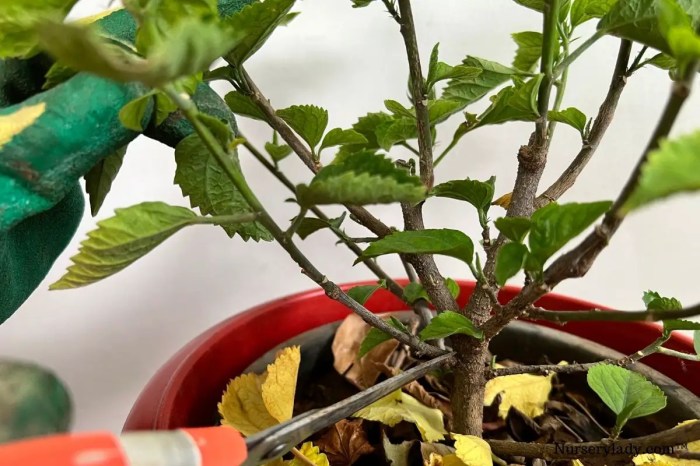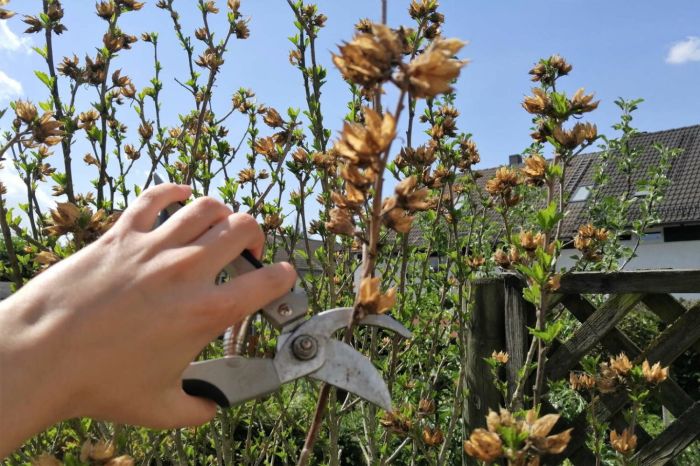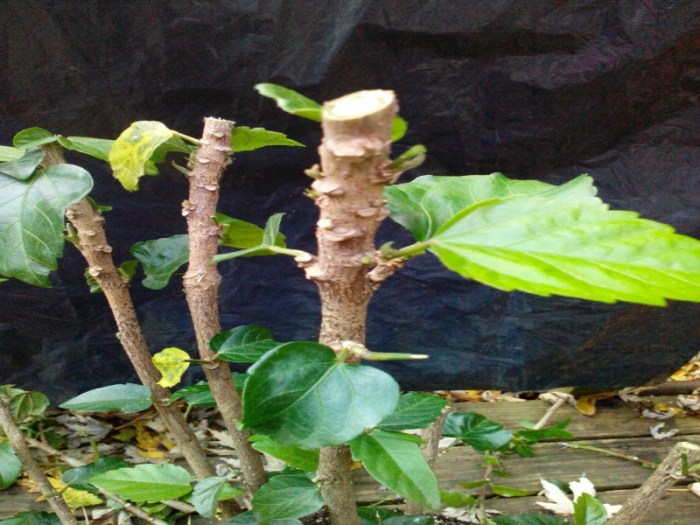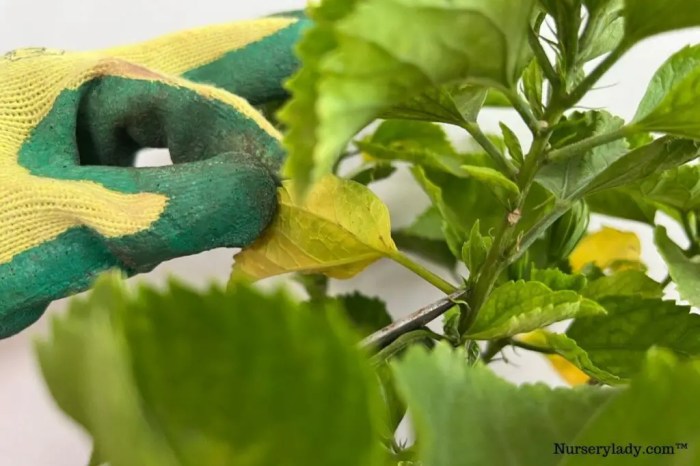Hibiscus plants are known for their vibrant blooms and lush foliage, but proper pruning is essential to maintain their beauty and encourage healthy growth. This guide will provide a comprehensive overview of how to prune hibiscus plants, including techniques, timing, purposes, tools, and aftercare.
By following these expert tips, you can effectively prune your hibiscus plants to achieve desired shapes, stimulate flowering, and promote overall plant health.
Pruning Techniques: How To Prune Hibiscus Plants

Pruning hibiscus plants is essential for maintaining their health and vigor, as well as promoting flowering. There are several different pruning methods that can be used on hibiscus plants, depending on the desired outcome.
The most common pruning method is tip pruning, which involves removing the tips of the branches to encourage branching and bushier growth. This method is best used on young plants or plants that have become leggy or overgrown.
Heading backis another common pruning method, which involves cutting back the branches to a desired length. This method is best used on mature plants or plants that have become too tall or wide. Heading back can also be used to remove dead or diseased branches.
Renewal pruningis a more drastic pruning method that involves cutting back the plant to the ground. This method is best used on old or neglected plants that have become overgrown or unproductive. Renewal pruning can help to rejuvenate the plant and encourage new growth.
When pruning hibiscus plants, it is important to use sharp, clean pruning shears. Cuts should be made at a 45-degree angle, just above a node or bud. It is also important to avoid over-pruning, as this can damage the plant and reduce flowering.
Diagram of Pruning Methods
[Insert diagram of pruning methods here]
Timing and Frequency of Pruning
The timing and frequency of pruning hibiscus plants are crucial factors that impact their overall health, vigor, and flowering performance. Understanding the optimal time to prune and how often to do it is essential for achieving the desired results.
The best time to prune hibiscus plants is during the late winter or early spring, just before new growth begins. This allows the plant to recover from pruning and redirect its energy towards producing new shoots and flowers.
Hibiscus plants should be pruned regularly, but the frequency depends on the specific variety and growing conditions. In general, it is recommended to prune hibiscus plants at least once a year, and more frequently for plants that are grown in warm climates or that produce a lot of new growth.
Determining When to Prune, How to prune hibiscus plants
There are several signs that indicate when a hibiscus plant needs to be pruned. These include:
- Excessive growth or legginess
- Weak or spindly stems
- Lack of flowering or poor flower production
li>Diseased or damaged branches
By observing these signs and following the recommended pruning schedule, you can keep your hibiscus plants healthy and productive for years to come.
Pruning for Specific Purposes

Pruning hibiscus plants serves various purposes beyond general maintenance. Specific pruning techniques can be employed to achieve specific goals, including shaping and size control, encouraging flowering, and removing dead or diseased wood.
To maintain the health and aesthetics of your hibiscus plants, pruning is essential. By removing dead or overgrown branches, you encourage new growth and flowering. While pruning techniques vary depending on the specific hibiscus variety, general guidelines include cutting back to just above a leaf node and removing any crossing or rubbing branches.
If you’re seeking inspiration for other plant designs, check out 10 Hanging Plants Revit Family Free Download: Enhance Your Designs with Realistic Greenery . This resource offers a range of 3D models that can elevate your designs with lifelike greenery.
Returning to hibiscus pruning, remember to use sharp, clean shears and follow proper safety precautions.
Shaping and Size Control
To shape hibiscus plants and control their size, selective pruning is necessary. This involves removing branches that are too long or growing in undesired directions. By cutting back these branches, the plant’s overall shape can be manipulated, creating a more compact or balanced appearance.
To maintain the health and beauty of hibiscus plants, regular pruning is essential. By removing dead or overgrown branches, you promote new growth and encourage abundant blooms. If you’re looking to add a touch of greenery to your rental apartment, consider 10 Hanging Plants to Elevate Your Rental Apartment . These versatile plants can bring life to any space, and they’re easy to care for.
Returning to the topic of hibiscus pruning, remember to use sharp, clean shears to avoid damaging the plant.
Regular pruning also prevents the plant from becoming overgrown and unruly.
Encouraging Flowering
Pruning can stimulate flowering in hibiscus plants by removing old or unproductive branches. When these branches are cut back, the plant’s energy is redirected to the remaining branches, promoting new growth and flower production. It is important to note that pruning should be done after the plant has finished flowering to avoid removing potential flower buds.
Removing Dead or Diseased Wood
Pruning is essential for removing dead or diseased wood from hibiscus plants. Dead branches can harbor pests and diseases, while diseased branches can spread infection throughout the plant. By removing these affected branches, the plant’s health and vigor can be maintained.
Pruning should be done using sharp, clean tools to prevent further damage to the plant.
Tools and Equipment

Pruning hibiscus plants requires the right tools and equipment to ensure clean cuts and minimize damage to the plant. Choosing the appropriate tools for the job depends on the size and age of the hibiscus plant, as well as the type of pruning being performed.
Essential Tools
*
-*Pruning shears
Bypass pruners are ideal for making precise cuts on small branches up to 1/2 inch in diameter. Anvil pruners are suitable for larger branches, but may crush the stems.
-
-*Loppers
For branches thicker than 1/2 inch, loppers provide greater leverage and cutting power.
-*Hand saw
Hibiscus plants thrive with regular pruning, which encourages bushier growth and more blooms. For optimal results, prune in late winter or early spring, removing dead or diseased branches. To maintain a compact shape, trim back stems by one-third to one-half their length.
While you’re considering indoor greenery, explore hanging plants indoor to add a touch of elegance to your home. With proper care, your hibiscus plants will flourish, providing vibrant blooms throughout the growing season.
For removing large branches or trunks, a hand saw with a fine-toothed blade is recommended.
Pruning hibiscus plants is crucial to maintain their health and shape. By removing dead or overgrown branches, you encourage new growth and flowering. Once you’ve mastered the art of pruning hibiscus, explore 10 Hanging Plants Pinterest: Beautify Your Home with Greenery for inspiration on incorporating lush greenery into your indoor spaces.
With proper care and pruning, your hibiscus plants will continue to thrive, adding beauty to your garden.
-*Sharpening stone
A sharpening stone is essential for maintaining sharp cutting edges on pruning tools.
-*Gloves
Wearing gloves protects hands from thorns and splinters.
Tips for Maintenance
* Clean pruning tools with rubbing alcohol or a disinfectant solution after each use to prevent the spread of disease.
- Sharpen tools regularly using a sharpening stone to ensure clean cuts and prevent tearing.
- Store tools in a dry place to prevent rust.
Aftercare and Maintenance

After pruning hibiscus plants, proper care is crucial for their recovery and optimal growth. Fertilization, watering, and protection from pests and diseases are essential aspects of aftercare.
Fertilizing
Fertilize pruned hibiscus plants with a balanced, slow-release fertilizer. Apply the fertilizer according to the manufacturer’s instructions, typically every 6-8 weeks during the growing season. Avoid over-fertilizing, as it can lead to root burn.
Watering
Water pruned hibiscus plants regularly, especially during hot, dry weather. Allow the soil to dry out slightly between waterings. Avoid overwatering, as this can cause root rot.
Protection
Protect pruned hibiscus plants from pests and diseases by spraying them with an insecticidal or fungicidal solution. This helps prevent infestations and infections that can weaken the plant. Additionally, remove any dead or diseased leaves or branches to minimize the spread of disease.
Common Problems and Prevention
*
-*Leaf drop
Over-pruning or underwatering can cause leaf drop. Ensure proper watering and avoid excessive pruning.
-
-*Yellowing leaves
Nitrogen deficiency can cause yellowing leaves. Fertilize the plant with a nitrogen-rich fertilizer.
-*Pest infestations
Aphids, spider mites, and mealybugs are common pests of hibiscus plants. Control infestations by spraying the plant with an insecticidal solution.
By following these aftercare tips, you can help your pruned hibiscus plants recover and thrive, ensuring their continued health and beauty.
Concluding Remarks
With the knowledge gained from this guide, you can confidently prune your hibiscus plants to enhance their aesthetic appeal and ensure their long-term well-being. Remember to consider the specific needs of your plants and adjust your pruning practices accordingly. By embracing the art of pruning, you can unlock the full potential of your hibiscus plants and enjoy their beauty for years to come.
General Inquiries
When is the best time to prune hibiscus plants?
The optimal time to prune hibiscus plants is in late winter or early spring before new growth begins.
How often should I prune my hibiscus plant?
Hibiscus plants should be pruned annually to maintain their shape and encourage flowering.
What are the different pruning techniques for hibiscus plants?
Common pruning techniques include deadheading, thinning, and shaping.